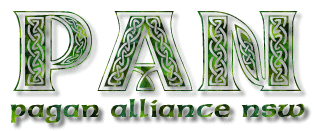|
Litha 1998 Newsletter Summer Solstice |

|
to the south it is glowing,
Red hot summers, that pass away slowly.
(Adrianne Harris, 1995)
The Summer Solstice (some traditions also call this time of year 'Litha'), is the longest day of the year, and this year occurs on December 22nd. The word 'solstice' comes from the Latin, meaning 'sun stood still', and in the midst of summer, it certainly feels that way. The sun will now begin to make its descent down to winter, where, at Yule, it will be reborn.
In Australia, the Solstice falls when many people take holidays, and spend time with their families. While we might be surrounded with images and thoughts of Yule, we only have to look outside to see the triumph of the sun over the materialisation of the season.
Some of our native plants rely on the searing heat of summer (and the bushfires caused by it), to stimulate the germination of seeds, and thus new life. While we look around a dry, and sometimes rainless country, we can take note of the new life emerging through the power of the sun. Life is also dying a his time. Plants die through lack of water and cool temperatures. We are constantly reminded by the bushfires how delicate life is, and how in order for life to survive, it must also be destroyed. The wheel of life is constantly in motion.
The Solstice is a time to celebrate life, to party and celebrate peace. Making flower headdresses is a traditional activity for the Solstice, with wreathes of sacred plants and herbs hung on houses for good luck and prosperity.
In literature, the Solstice is noted in Shakespeare's A Midsummer Night's Dream. The leading characters in this play are the fairies who interact with the world throughout the duration of the play. In folklore, it is believed that the Summer Solstice is a time when fairies could would bestow luck on humans. An old ritual was to place food out in the garden for the fairies, who would sometimes leave crystals as a token of thanks.
Sun Deities
Some Sun deities of the world include:
Shamash - a Sumerian God of justice. He is symbolised by the sun disk and a four pointed star surrounded by rays.
Ra - the Egyptian Sun God
Sol - the Roman God that corresponds to the Greek Helios
Sol - the Icelandic Goddess of the Sun
Father Sun - the 'generic' name used by many Pagans to describe, 'he who lives in the sky'
![]()